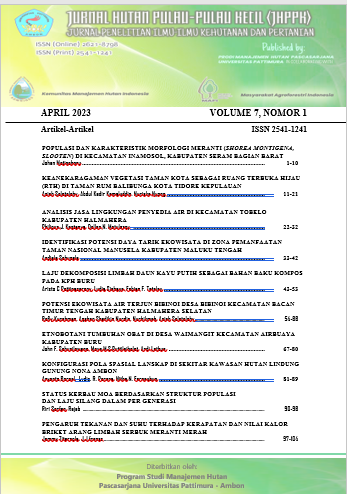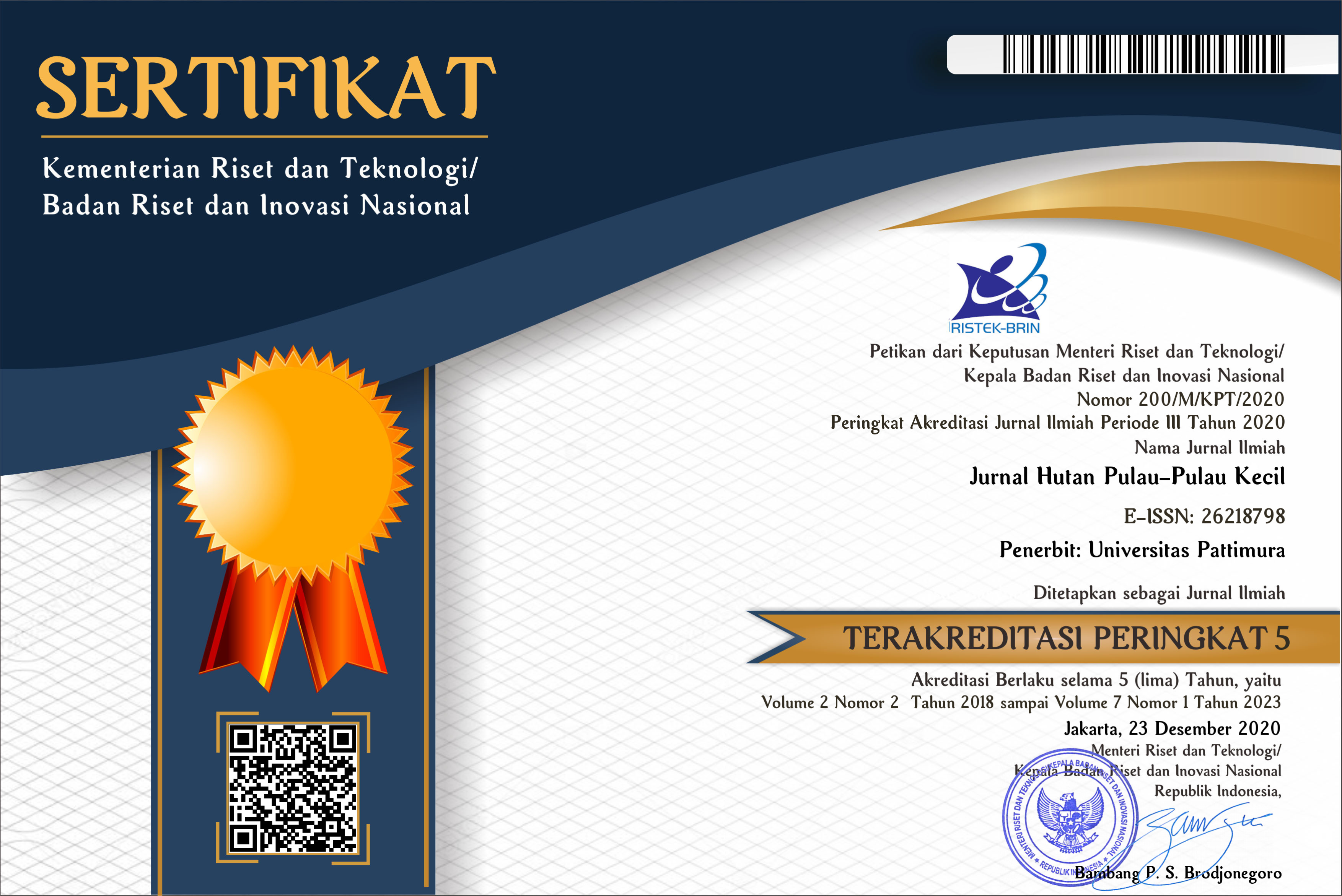KONFIGURASI POLA SPASIAL LANSKAP DI SEKITAR KAWASAN HUTAN LINDUNG GUNUNG NONA AMBON
Abstract
This research aims to observe land use changes and analyze the configuration of spatial landscape patterns around the protected forest area of Gunung Nona Ambon in 2014 - 2020. This research was conducted with two analyses. The first stage is identifying land cover/land use changes in the last 6 years (2014 - 2020) through spatial analysis (overlay). The second stage is to analyze the configuration of spatial patterns of forest landscapes using the spatial metrics method. The results showed that during the 6-year period (2014-2020), the forest class experienced significant changes. Changes in forest land use around the HLGN area dominantly occurred in the settlement class, followed by shrubs and open land classes of 5.62%, 5.37% and 3.38% respectively of the existing forest area in the study area. The configuration of spatial patterns of settlement land such as density and continuity showed that the spatial patterns were increasingly concentrated and dense and the areas were physically connected to each other. Similarly, the fragmentation indicator shows that the settlement land pattern is increasingly massive and clustered.
Downloads
References
Agung, A., Sigit, A., Putra, P., & Satiawan, R. (2018). Perumusan Faktor- Faktor Perubahan Tol Waru-Juanda di Kelurahan Tambakoso Kabupaten Sidoarjo. Jurnal Teknik ITS, Vol 7(2), pp:173–179.
Andryannur, H., Akbar, A. A., & Sulastri, A. (2022). Pengaruh Perubahan Tutupan Lahan Terhadap Jasa Ekosistem Pangan Di Taman Nasional Danau Sentarum. Jurnal Ilmu Lingkungan, Vol 20(3),pp: 615–627.
Ariez, M., Gul, K., Larwai, M. I., & Amin, A. (2022). Forest Cover Change Detection In Paktia Province Of Afghanistan Using Remote Sensing And GIS : 1998-2018. Vol 5(2), pp:169–177.
Boreel, A., Parera, L., & Meliani. (2022). Analisis Faktor Pendorong Perubahan Penggunaan Lahan Menggunakan Metode Analytical Hierarchy Process ( AHP ) ( Kasus : Das Waeruhu Kota Ambon ) Driving Factor Analysis Of Land Use Change Using Analytical Hierarchy. Jurnal Hutan Pulau-Pulau Kecil, Vol 6(2),pp: 203–210.
Budi, S. 2020. Identifikasi Tutupan Lahan Sebelum & Sesudah Kebakaran Hutan dan Lahan Pada Tahun 2019 di Provinsi Riau. Riau: Departemen Konservasi Sumberdaya Hutan.
Firmansyah F. (2018). Spatial pattern analysis using spatial metrics : a case study in Surabaya , Indonesia Spatial pattern analysis using spatial metrics : a case study in Surabaya , Indonesia. IOP Conference Series: Earth and Environmental Science Paper.
Farneubun, N. N., Boreel, A., & Loppies, R. (2023). Jurnal Agrosilvopasture-Tech Dinamika Perubahan Lahan di Sekitar Kawasan Hutan Lindung Gunung Nona serta Faktor-Faktor yang Mempengaruhinya Dynamics of Landuse Change Around the Gunung Nona Protected Forest Area and Influencing Factors. Vol 2(1), pp:29–36.
Hapsary, M. S. A., Subiyanto, S., & Firdaus, H. S. (2021). Analisis Prediksi Perubahan Penggunaan Lahan Dengan Pendekatan Artificial Neural Network Dan Regresi Logistik Di Kota Balikpapan. Jurnal Geodesi UNDIP, Vol 10(2), pp: 88–97. https://ejournal3.undip.ac.id/index.php/geodesi/article/view/30637
Hastuti, Mappamiring, & Abdi. (2021). Pengelolaan kawasan hutan lindung di unit pelaksana teknis kesatuan pengelolaan hutan mata allo Kabupaten Enrekang. Jurnal Universitas Muhammadiyah Makassar, Vol 2(1), pp:172–185.
Herold, M., Couclelis, H., and Clarke, K.C. 2003. The Role of Spatial Metrics in the Analysis and Modeling of Urban Land Use Change. Computers, Environment and Urban Systems, Vol. 29(2),pp: 369–399
Hussain S., Mubeen M., Karuppanaan S. 2022. Land use and land cover (LULC) change analysis using TM, ETM+ and OLI Landsat images in district of Okara, Punjab, Pakistan. Physic and Chemistry of The Earth, Parts A/B/C. Volume 126. Elsevier.
Jatayu, A., Rustiadi, E., & Pribadi, D. O. (2020). A quantitative approach to characterizing the changes and managing urban form for sustaining the suburb of a mega-urban region: The case of north cianjur. Sustainability (Switzerland), Vol 12(19), pp: 1–21. https://doi.org/10.3390/su12198085
Kirabira, A. (2022). Topic : Urban growth monitoring using spatial landscape. March, 0–2. https://doi.org/10.14293/S2199-1006.1.SOR-.PPF7VSL.v1
McGarigal, K., & Marks, B. J. (1995). FRAGSTATS: spatial pattern analysis program for quantifying landscape structure. General Technical Report - US Department of Agriculture, Forest Service, PNW-GTR-351.
McGarigal, K., S A. Cushman, M.C. Neel, and E. Ene. 2002. FRAGSTATS: Spatial Pattern Analysis Program for Categorical Maps. Computer software program produced by the authors at the University of Massachusetts, Amherst. Available at the following web site: www.umass.edu/landeco/research/fragstats/fragstats.html.
Minh Hai, P., & Yamaguchi, Y. (2007). Characterizing the Urban Growth From 1975 to 2003 of Hanoi City Using Remote Sensing and A Spatial Metric, Vol.21 (2),pp:104–110.
Nabila, D. A. (2023). Pemodelan prediksi dan kesesuaian perubahan penggunaan lahan menggunakan Cellular Automata-Artificial Neural Network (CA-ANN). Tunas Agraria, Vol 6(1),pp: 41–55.
Nath, B., Wang, Z., Ge, Y., Islam, K., Singh, R. P., & Niu, Z. (2020). Land use and land cover change modeling and future potential landscape risk assessment using Markov-CA model and analytical hierarchy process. ISPRS International Journal of Geo-Information, Vol 9(2),pp:134
Permana, M., Sitorus, S. R. P., & Darmawan, D. (2021). Analisis Perubahan Penggunaan Lahan Dan Prediksinya dengan Menggunakan Markov – Cellular Automata Di Wilayah Peri Urban Kota Malang. Tataloka, Vol 23(3),pp: 307–319.
Reis, J. P., Silva, E. M., and Pinho, P. 2015. Spatial Metrics to Study Urban Patterns in Growing and Shrinking Cities. Urban Geography, Vol. 37, 246-271.Reneng, A. W., Ekamawanti, A. H., & Astiani, D. (2022). Jurnal Lingkungan Hutan Tropis. Vol 1(1),pp: 121–137.
Reneng, A. W., Ekamawanti, A. H., & Astiani, D. (2022). Jurnal Lingkungan Hutan Tropis. Vol 1(1),pp: 121–137.
Sajib, A. M., & Moniruzzaman, M. (2022). Driving Forces of Landuse and Landcover Changes in the North-eastern Part of Dhaka Conurbation. The Dhaka University Journal of Earth and Environmental Sciences, Vol 10(2), pp:53–66. https://doi.org/10.3329/dujees.v10i2.57515
Saputra, M., Nugraha, I., Agus, F., & Hidayah, A. (2022). Prediksi Perubahan Penutup Lahan menggunakan Integrasi Celullar Automata dan Analytical Hierarchy Process (AHP)(Studi Kasus: Kota Pekanbaru). Journal of Urban Regional Planning and Sustainable Environment, Vol 1(1),pp: 1–13.
Sari, Y. A., & Dewanti, D. (2019). Perubahan Penggunaan Lahan Dan Faktor-Faktor Yang Mempengaruhi Di Sekitar Area Panam Kota Pekanbaru. Seminar Nasional Geomatika, 3, 751.
Setiawan, F. (2021). Analisis Perubahan Tutupan/Penggunaan Lahan Kabupaten Bangka Selatan Tahun 2015-2020. Proceedings of National Colloquium 209–213.




